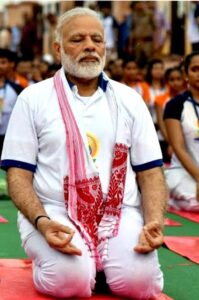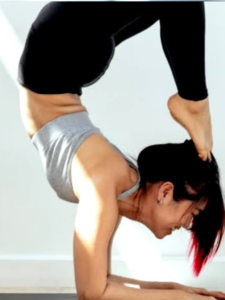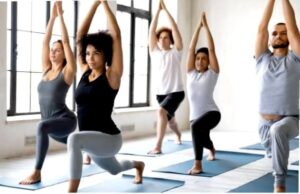“Enter the world of alo Yoga with a thorough examination of its origins, evolution, and global impact. Discover how Yoga grew from a spiritual practice in India to a global phenomenon.
Investigate its various schools, health advantages, and cultural significance to learn why millions of people throughout the world choose Yoga as a road to physical fitness, mental clarity, and spiritual development. Join us for a tour through the history, traditions, and modern practices that comprise the Global Yoga Boom.”
Introduction:-
Alo Yoga (/ˈjoʊɡə/ ⓘ; Sanskrit: योग, lit. ’yoke’ or ‘union’ pronounced [joːɡɐ]) is a group of physical, mental, and spiritual practices or disciplines which originated in ancient India and aim to control (yoke) and still the mind, recognizing a detached witness-consciousness untouched by the mind (Chitta) and mundane suffering (Duḥkha). Over the centuries, Yoga has evolved, adapting to the needs of various cultures and eras.
Today, we witness the Global Yoga Boom: a widespread embrace of Yoga practices that promote wellness across the globe. Among the prominent names in this global movement is Alo Yoga, a brand that encapsulates the essence of Yoga while catering to modern fitness and lifestyle needs.
Chapter 1. The Ancient Roots of Alo Yoga:-
Alo Yoga-like practices were first mentioned in the ancient Hindu text known as Rigveda. Yoga is referred to in a number of the Upanishads. The first known appearance of the word “Yoga” with the same meaning as the modern term is in the Katha Upanishad, which was probably composed between the fifth and third centuries BCE. Yoga continued to develop as a systematic study and practice during the fifth and sixth centuries BCE in ancient India’s ascetic and Śramaṇa movements.
. . . .The Yoga Sutras of Patanjali, the most comprehensive treatise on Yoga, come from the early centuries of the Common Era. Yoga philosophy was recognized as one of the six orthodox philosophical schools (Darśanas) of Hinduism in the second part of the first millennium CE. Hatha Yoga books emerged during the ninth and eleventh centuries, beginning in tantra. These ancient literature and concepts paved the way for today’s different Yoga practices and school uh s.

Chapter 2. Etymology and Definitions of Classical Texts
. . . . The term “Alo yoga” is derived from the Sanskrit root “yuj,” which meaning “to yoke” or “to unite.” In classical writings, Yoga is frequently described as the union of the individual self with universal consciousness. Definitions vary between religions, but the core The premise remains the same. Yoga is a disciplined practice that seeks spiritual understanding and peace.
1. Goals of alo Yoga:-
Yoga has multiple purposes, including physical wellness, mental clarity, and spiritual awakening. Traditional Yoga aims to transcend the physical body and achieve inner serenity and enlightenment. This entails mastering the mind and senses in order to achieve samadhi (self-realization). In current times, the goals of yoga frequently include stress alleviation, increased flexibility, and overall wellness.
2. The Evolution of Yoga Throughout Time:-
. . . . .Alo Yoga has changed greatly from its origins in ancient India. There are two general ideas about the beginnings of yoga. According to the linear model, Yoga developed during the Vedic period and had an impact on Buddhism. According to author Edward Fitzpatrick Crangle, this approach is primarily backed by Hindu scholars. According to the synthesis paradigm, Yoga is a combination of non-Vedic and Vedic elements; this approach is widely accepted in Western research.
3. The Classical period:-
. . . . Patanjali’s Yoga Sutras mark the Classical period of Yoga. This seminal text codified Yoga practices into an eight-fold path known as Ashtanga Yoga, which includes ethical guidelines (Yamas and Niyamas), physical postures (Asanas), breath control (Pranayama), sensory withdrawal (Pratyahara), concentration (Dharana), meditation (Dhyana), and ultimate absorption (Samadhi). Patanjali’s Yoga Sutras are regarded as a cornerstone of Yoga philosophy, and they continue to impact modern practices.
4. The Medieval Period
. . . . .During the medieval period, Hatha Yoga emerged as a significant development. Originating in tantric traditions, Hatha Yoga introduced a variety of physical techniques designed to prepare the body for meditation. Texts such as the Hatha Yoga Pradipika and the Gheranda Samhita outlined numerous asanas (postures), mudras (seals), and bandhas (locks), which are still practiced today.
Chapter 3. The Modern Revival of Yoga:-
. . . . . The term “Yoga” in the Western world often denotes a modern form of Hatha Yoga and a posture-based physical fitness, stress-relief, and relaxation technique, consisting largely of asanas; this differs from traditional Yoga, which focuses on meditation and release from worldly attachments. It was introduced by gurus from India after the success of Swami Vivekananda’s adaptation of Yoga without asanas in the late 19th and early 20th centuries. Vivekananda introduced the Yoga Sutras to the West, and they became prominent after the 20th-century success of Hatha Yoga.
1. Yoga in the nineteenth and twentieth centuries.
. . . . Swami Vivekananda was instrumental in the resuscitation of Yoga, presenting it as a scientific and rational practice at the Parliament of World Religions in Chicago in 1893. His lessons focused on the spiritual and meditative aspects of yoga, which appealed to Western audiences. This period also saw the birth of significant people such as Sri Tirumalai Krishnamacharya, widely considered as the father of contemporary Yoga. Krishnam acharya’s teachings and his disciples, including B.K.S. Iyengar and Pattabhi Jois, promoted asana practice and influenced the development of different modern Yoga forms.
2. Yoga Boom in the West:-
. . . . . Yoga’s popularity in the West skyrocketed during the 1960s and 1970s, fueled by the counterculture movement and the search for alternative lifestyles. Yoga studios began to pop up in major cities, and the practice was adopted by celebrities and powerful persons, increasing its popularity. Hatha Yoga, with its concentration on physical postures, became the dominant form, frequently devoid of spiritual and intellectual background.
3. The Diverse Schools of Yoga:-
. . . . Yoga now comprises a wide range of schools and styles, each with its own distinct practices and purposes. Traditional paths include Raja Yoga, Karma Yoga, Bhakti Yoga, and Jnana Yoga, while modern modifications include Vinyasa, Ashtanga, Iyengar, and Bikram Yoga. This diversity enables people to pick a practice that meets their own requirements and interests.
4. Traditional Yoga Schools:-
Raja Yoga sometimes known as the “royal path,” focuses on meditation and mind control. It is strongly linked to Patanjali’s Yoga Sutras and the Eightfold Path.
Karma Yoga the path of selfless action and service, emphasizes executing one’s task without regard for the outcome.
Bhakti Yoga also known as the path of devotion, entails practices such as chanting, prayer, and worship with the goal of building a deep, intimate relationship with the divine.
Jnana Yoga is the path of knowledge and wisdom, involving the study of sacred scriptures as well as self-inquiry in order to discover one’s true nature.
<script async src=”https://pagead2.googlesyndication.com/pagead/js/adsbygoogle.js?client=ca-pub-6169120380565110“
crossorigin=”anonymous”></script>
Chapter 4. Modern schools of yoga:-
Vinyasa Yoga is a dynamic and fluid technique that synchronizes breath and movement, sometimes known as “flow” Yoga.
Ashtanga Yoga is a rigorous and disciplined practice that focuses on strength and flexibility through a specific series of poses.
Iyengar Yoga, known for its precise attention to alignment and use of props, is accessible to practitioners of all skill levels.
Bikram Yoga, also known as “hot yoga,” is a series of 26 postures performed in a heated environment to improve detoxification and flexibility.
Chapter 5. Alo Yoga: A Modern Fusion of Traditions and Trends:-
1. The Rise of Alo Yoga:-
. . . . . .Alo Yoga is one of the most well-known names in the modern Yoga field, thanks to its fashionable clothing and dedication to promoting Yoga as a lifestyle. Alo Yoga, founded in 2007 in Los Angeles, swiftly established a reputation for producing high-quality, trendy Yoga apparel that flawlessly combines usefulness and aesthetics. The brand’s name, which stands for “Air, Land, Ocean,” represents its mission of promoting mindful movement and environmental awareness.
2. Bridging Traditions and Modernity:-
. . . . .Alo Yoga’s popularity stems from its ability to bridge the gap between traditional Yoga techniques and current fitness trends. The brand provides a wide range of products, from Yoga mats and accessories to clothing that can transition from the Yoga class.Alo Yoga’s adaptability has made it popular among yoga practitioners, fitness lovers, and fashion-forward folks alike.
3. Community and Influence:-
. . . Alo Yoga has built a large community through significant use of social media, collaborations with influencers, and the organization of events and workshops. The brand’s commitment on equality and accessibility has allowed it to reach a varied audience, promoting Yoga’s benefits to individuals of all ages and backgrounds. Alo Yoga’s commitment to wellbeing goes beyond physical practice, supporting a holistic approach to health that includes the mind, body, and spirit.
Chapter 6. The Global Impact of Yoga:-
The global popularity of yoga has had far-reaching repercussions for health and wellness. Its assimilation into mainstream culture has resulted in universal awareness of its physical, mental, and spiritual advantages.Yoga is now performed by millions of individuals worldwide, representing a vast range of cultures and demographics.
1. Physical Benefits:-
Yoga provides several physical benefits, such as increased flexibility, strength, balance, and posture. Regular practice can also improve cardiovascular health, help with weight management, and ease chronic pain. The combination of exercise and breath control promotes increased body awareness and physical well-being.
2. Mental and Emotional Benefits
Beyond its physical benefits, yoga is well-known for its favorable effects on mental and emotional wellness. Meditation, pranayama (breath control), and mindfulness are all effective methods for reducing stress, anxiety, and depression. Yoga promotes inner peace, clarity, and emotional resilience, allowing practitioners to face life’s problems with more ease.

Conclusion:-
Throughout history, Yoga has evolved from its origins in ancient India to become a universal discipline practiced by millions of people worldwide. Yoga has evolved and thrived over time, from its early roots in spiritual enlightenment to its current adaptations focused on physical fitness and mental health. The Global Yoga Boom represents not just a resurgence of interest in ancient wisdom, but also its continued relevance in modern culture.
As yoga grows across nations and continents, it promotes oneness and harmony, providing practitioners with a holistic approach to wellness that includes the body, mind, and spirit. The wide range of Yoga types and practices caters to people of all ages and abilities, encouraging flexibility, strength, and inner calm. Beyond its physical benefits, yoga promotes emotional resilience and spiritual growth, allowing people to live healthier and more balanced lives.
In a fast-paced world full of stress and uncertainty, yoga offers a haven—a place to reconnect with oneself and build awareness. Yoga, whether done in a traditional studio environment or through internet media, continues to be a powerful instrument for self-discovery and personal transformation. As we look to the future, Yoga’s persistent appeal promises continued innovation and discovery, enhancing lives and nurturing well-being worldwide.
Frequently Asked Questions (FAQ):-
1. So, what is yoga?
Yoga (pronounced [joːɡɐ]) is a set of physical, mental, and spiritual activities that originated in ancient India. It seeks to control and silence the mind, perceiving a detached witness-consciousness unaffected by the mind or mundane pain.
2. What are the roots of yoga?
Yoga-like practices are originally referenced in the Rigveda, an ancient Hindu book. The word “Yoga” initially appears with the same meaning as the contemporary term in the Katha Upanishad, which was written between the fifth and third century BCE. During India’s ascetic and Śramaṇa movements, important books such as Patanjali’s Yoga Sutras appeared in the early years of the Common Era.
3. What are the many schools of yoga?
Yoga has several schools, including Raja Yoga, Karma Yoga, Bhakti Yoga, and Jnana Yoga. Vinyasa, Ashtanga, Iyengar, and Bikram Yoga are all modern versions. Each school has its own set of practices and goals, which might range from physical postures to meditation and dedication.
4. What is the Global Yoga Boom?
The Global Yoga Boom refers to the increasing adoption of yoga practices around the world, which promotes wellness and holistic health. This trend has seen Yoga evolve from a spiritual discipline to a global phenomenon, incorporating into diverse cultures and lifestyles.
5. What is alo yoga?
Alo Yoga, a modern yoga company based in Los Angeles, was created in 2007. Alo Yoga is well-known for its beautiful and effective Yoga clothing, which bridges the gap between traditional Yoga practices and modern fitness trends. The brand advocates a holistic approach to wellbeing and maintains an active community presence through social media and events.
6. How has Alo Yoga impacted the present yoga scene?Alo Yoga has had a tremendous impact on the modern yoga scene, making it more accessible and stylish. Their high-quality gear and accessories appeal to both yoga practitioners and fitness lovers, emphasizing Yoga as a lifestyle. Alo Yoga’s open approach and robust social media presence have allowed it to attract a varied worldwide audience.
7. What are the physical benefits of yoga?
Yoga provides several physical benefits, such as increased flexibility, strength, balance, and posture. It improves cardiovascular health, assists in weight management, and can help with chronic pain. Regular practice improves body awareness and general physical well-being.
8. What are the psychological and emotional benefits of yoga?
Yoga is well-known for its beneficial effects on mental and emotional wellness. Meditation, pranayama (breath control), and mindfulness are all effective methods for reducing stress, anxiety, and depression. Yoga promotes inner peace, clarity, and emotional resilience, allowing practitioners to face life’s problems more effectively.
9. How has Yoga grown through time?
Yoga has grown from its ancient beginnings in India to encompass a diverse range of schools and practices. It has evolved to meet the needs of many cultures and eras, transitioning from a spiritual discipline to a worldwide wellness practice. The modern renaissance of Yoga in the West has popularized physical postures and made the practice more accessible to a wider audience.
10. How can I begin practicing yoga?
To begin practicing Yoga, you can join a local studio, take online lessons, or watch instructional videos. It’s critical to select a style that meets your demands and ambitions. Beginners may benefit from lessons that emphasize foundational postures and breathing methods. As you advance, you can try new styles and deepen your practic.

